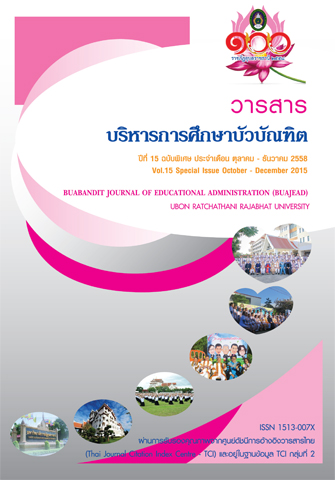รูปแบบการพัฒนาสมรรถนะการพูดภาษาอังกฤษของครูผู้สอนที่มีวุฒิไม่ตรงสาขา โรงเรียนประถมศึกษาในภาคตะวันออกเฉียงเหนือ
Main Article Content
บทคัดย่อ
การวิจัยครั้งนี้ มีวัตถุประสงค์คือ 1. เพื่อศึกษาปัญหาและแนวทางพัฒนาสมรรถนะการพูด ภาษาอังกฤษของครูผู้สอนที่มีวุฒิไม่ตรงสาขาโรงเรียนประถมศึกษาในภาคตะวันออกเฉียงเหนือ โดยการศึกษา เอกสารงานวิจัยที่เกี่ยวข้อง การสอบถามความคิดเห็นของกลุ่มตัวอย่าง จำนวน 375 คน จากโรงเรียนในภาค ตะวันออกเฉียงเหนือ 20 โรงเรียน การประชุมสนทนากลุ่ม (Focus Group) กลุ่มเป้าหมายคือผู้ทรงคุณวุฒิ จำนวน 9 คน 2. เพื่อสร้างและพัฒนารูปแบบ โดยการสัมภาษณ์ผู้ทรงคุณวุฒิ จำนวน 5 คน 3. เพื่อศึกษาผล การใช้รูปแบบ กลุ่มเป้าหมายคือครูผู้สอน จำนวน 15 คน ผู้บริหารจำนวน 5 คน ใน 5 โรงเรียน 4. เพื่อตรวจสอบ และประเมินรูปแบบโดยการประชุมอิงผู้เชี่ยวชาญ (Connoisseurship) กลุ่มเป้าหมายคือผู้ทรงคุณวุฒิ จำนวน 9 คน เครื่องมือที่ใช้คือ แบบสอบถาม แบบบันทึกการประชุม แบบสัมภาษณ์ แบบทดสอบ แบบสังเกตพฤติกรรมการพูด แบบบันทึกการประชุมสะท้อนผล สถิติที่ใช้ในการวิเคราะห์ข้อมูลเชิงปริมาณและเชิงคุณภาพ คือ ค่าร้อยละ ค่าเฉลี่ย ส่วนเบี่ยงเบนมาตรฐาน
ผลการวิจัยพบว่า 1. ครูมีปัญหาสมรรถนะในการพูดภาษาอังกฤษ ทั้งสมรรถนะด้านความรู้ และ สมรรถนะด้านทักษะอยู่ในระดับปานกลาง และสมรรถนะด้านคุณลักษณะอยู่ในระดับสูง สาเหตุเพราะว่าครูผู้สอน ส่วนมากเป็นครูที่มีวุฒิไม่ตรงสาขาและไม่ได้รับการพัฒนาที่ต่อเนื่อง และขาดแรงจูงใจในการพัฒนา ส่วนแนวทาง พัฒนาพบว่าครูผู้สอนส่วนมากต้องการการอบรมและการสอนงานระบบพี่เลี้ยงโดยใช้วิทยากรทั้งชาวไทยและ ชาวต่างประเทศและมีพี่เลี้ยงเป็นครูผู้สอนที่มีความเชี่ยวชาญด้านภาษาอังกฤษ และผู้ทรงคุณวุฒิเสนอว่าควรใช้ กิจกรรมที่หลากหลายเหมาะสมกับความรู้ วัย และประโยชน์ในการนำไปใช้ เนื้อหาควรครอบคลุมกับปัญหาสมรรถนะ ทั้ง 3 ด้าน โดยใช้กระบวนการอบรมเชิงปฏิบัติการและการสอนงานระบบพี่เลี้ยง 2. การสร้างและพัฒนารูปแบบ สรุปได้ว่า รูปแบบประกอบด้วยสมรรถนะในการพูดภาษาอังกฤษ 3 สมรรถนะหลัก 8 สมรรถนะย่อย 18 ตัวชี้วัด โดยใช้กระบวนการพัฒนาเป็น 3 กระบวนการ คือ การอบรมเชิงปฏิบัติการ การเรียนรู้ด้วยตนเองและการสอน งานระบบพี่เลี้ยง 3. ผลการนำรูปแบบไปใช้โดยดำเนินตามขั้นตอนวิจัยเชิงปฏิบัติการ (PAOR) 2 วงรอบ ในเวลา 3 เดือน พบว่า กลุ่มเป้าหมายทุกโรงเรียน มีค่าคะแนนเฉลี่ยสมรรถนะด้านความรู้เพิ่มขึ้น มีพฤติกรรมการพูด อยู่ในระดับดีและมีความพึงพอใจต่อรูปแบบอยู่ในระดับมาก 4. ผลการตรวจสอบและประเมินรูปแบบพบว่า รูปแบบมีความเหมาะสมและมีความเป็นไปได้ในระดับมากที่สุด มีค่าเฉลี่ย 4.54 และ 4.51 ตามลำดับ
A Model of Developing English Speaking Competency of Non-English Major Primary Teachers in the Northeast of Thailand
This research aims were as follows; firstly, to study the English speaking competency problems and highlight ways to improve their English speaking competency among non-English major primary school teachers in Northeast Thailand. By literature review, also, 375 non-English major primary school teachers from 20 provinces in the Northeast of Thailand were samples for giving their opinions. The focus group method was used to collect opinions and suggestions from 9 experts. Secondly, to establish and develop an appropriate model which based on the opinions of 5 experts by in-depth interview method. Thirdly, to implement this model with the target groups: 5 principals and 15 non-English major primary teachers. Lastly, to assess and evaluate the model by connoisseurship with 9 experts. The research instruments were questionnaires, meeting note taking form, interview questions form, speaking observation form and reflection form. Quantitative and qualitative data were analyzed by using statistics through percentage, mean, and standard deviation.
The results showed that; 1. non–English teachers had the problems of English speaking competency. Their English speaking knowledge and skill competencies were at moderate level while attribute competencies was at high level. That was because most of them did not study English language as a major during formal university study and they have not been trained continually. The highlight ways to improve their English speaking competencies indicated that they would like to be trained by Coaching and Mentoring with both Thai and native English speaking experts. They also requested mentors who are English experts. In addition, the experts suggested that they should be attended in the variety appropriate workshops which appropriate for their knowledge and age and applicable to use. The curriculums should cover those 3 competency problems. 2. The establishing and developing model by in-deft interview with 5 experts can be concluded that this model consists of 3 main English speaking competencies, 8 sub-competencies and 18 indicators with 3 processes: workshop, selflearning and coaching and mentoring. 3. After implementation the model with 2 cycles of action research (PAOR) within three months, the English speaking knowledge competency of teachers in every school were improved. Their English speaking met the high level. Moreover, these teachers satisfied this model at the high level. 4. Experts agreed that for develop English speaking competency, this model is appropriate and possible at the highest level with a mean of 4.54 and 4.51, respectively.

